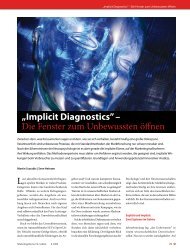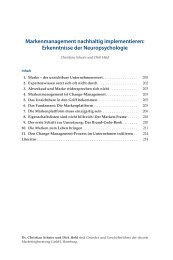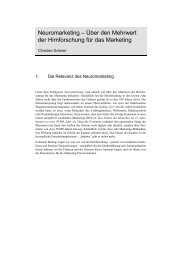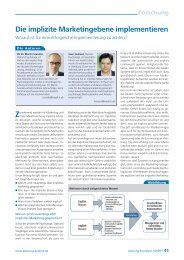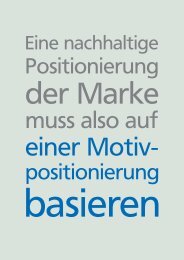Newness - Science Update - decode Marketingberatung
Newness - Science Update - decode Marketingberatung
Newness - Science Update - decode Marketingberatung
- No tags were found...
Create successful ePaper yourself
Turn your PDF publications into a flip-book with our unique Google optimized e-Paper software.
<strong>decode</strong> <strong>Science</strong> <strong>Update</strong> 2_11Familiar and New – Squaring the Circle?Why communication has to be both new and familiarsimultaneously, and how to resolve this dilemma.October 2011Page 1
Welcome to the <strong>decode</strong> <strong>Science</strong> <strong>Update</strong>A recent study by the University of Tokyo identified two main drivers of advertising effectiveness:<strong>Newness</strong> and Familiarity.These factors are not surprising. To be consistent, yet at the same time differentiated, is one of the biggestchallenges in marketing communication. It‘s a bit like squaring the circle. Little wonder then that we have many adiscussion in our everyday Marketing lives about this topic - what should we keep and what should we, or must we,change?In this <strong>Science</strong> <strong>Update</strong> we take a closer look at what science has to offer on the issue of newness versusfamiliarity. Cognitive science is particularly useful here: How can we structure our communications in an optimalway to allow the consumer to learn? Let‘s take a look, therefore, at the principles by which we humans deal withnew and familiar information. These insights actually present a neat solution to the perceived dilemma of ‘new andfamiliar‘.We hope you enjoy reading this <strong>Update</strong>!Your <strong>decode</strong> TeamDr. Christian Scheier Dirk Held PD Dr. Martin Scarabis Johannes Schneider Dr. Dirk Bayas-Linke Tobias EckertPage 2
Why do we find it difficult to learn new things?Cognitive psychologists have known for a long time that our brain learns best when we can integrate newknowledge into pre-existing knowledge. Therefore, familiarity is very important for advertising effectiveness andefficiency. That much we know.But why do we humans find it so hard to learn new things? How is it that something new is often rejected anddisliked by consumers, or that when recalling recent advertising from ad tracking, consumers often talk aboutcontent which hasn‘t been part of the campaign for a long time? It is down to the way the brain responds tostimulation.Based on all our experiences, gained directly or indirectly, consciously or unconsciously, our brain formsexpectations. These expectations control our subsequent attention and the interpretation of stimuli and messages.So when a brand communicates, it creates expectations. Neuroscientist Moshe Bar from Harvard Medical Schoolcomments as follows:“The human brain is not a passive organ simply waiting to be activated by external stimuli. The brain continuouslyemploys past experiences to interpret sensory information and predict the immediately relevant future.“We tend to validate our own expectations where possible – especially if they have served us well in the past, havenot been problematic or if they’re simply not that important to us. These requirements are true for most consumergoods. Hence, communicating new messages to consumers efficiently is by no means trivial. This tendency caneven be observed at a sensory cellular level, as new tests show. Let‘s take a closer look at these results.Page 3
Predictive Coding-PrincipleResearchers at the Radboud University in Nijmegen (Netherlands) observed nerve cells reacting to familiar and new– i.e. unexpected – information. As soon as we expect something and our hypothesis is confirmed by a signal, ourbrain switches off and attends to other matters. This is very efficient. Why should we spend more time consideringsomething when we already know what it is?ExpectedUnexpectedThe illustration shows cell activity in response to expected and unexpectedsignals. If a signal was expected – i.e. is consistent with expectation – thenthis information is not processed further. Information that matchesexpectation is suppressed. Cells switch off and concentrate on other things.Source: Todorovic A, van Ede F, Maris E, de Lange FP (2011). Prior expectation mediates neuraladaptation to repeated sounds in the auditory cortex: an MEG study. Journal of Neuroscience 31,9118-23This neuronal switching-off effect is also the reason why most car crashes happen on roads that we know best. Weno longer concentrate enough and our brain completes the information from memory. Researchers call this“Repetition Suppression“.This is why communication has to be new in order for consumer learning to be achieved. In other words: Withoutnewness nothing is learned. <strong>Newness</strong> opens the door for new things to be communicated.Page 4
The MAYA-Principle: Most Advanced, Yet AcceptableBut how much newness can the consumer cope with? How much familiarity is necessary? “Disruptive“communication, which goes completely against expectations, does create attention and higher cognitive activity– consumers try to solve the inconsistency – but can only be kept up long-term in exceptional cases and thisrequires the recipient to be highly involved. Advertising, however, (and advertising researchers are in agreement onthis) is usually processed with low involvement. Research shows that the most effective strategy to utilise is theMAYA-Principle: Most Advanced Yet Acceptable. Many studies agree that a message that is moderately incongruentwith expectations is the most efficient at increasing:(a) Attention, (b) Liking and (c) Recall and Recognition. .AttentionRecallLikingModerate incongruities work best. Total newnesshas just as little effect as total familiarity.lowmediumReactivation of Familiarity<strong>Newness</strong>highIrritationSource: Halkias, G. & Kokkinaki, F. (2010). Attention, Memory, andEvaluation of Schema Incongruent Brand Messages: An Empirical Study. LabSiConference on “Neuroscience and Decision MakingPage 5
The MAYA-Principle in Product DesignThe question of how much newness the consumer can cope with is also one of the central questionsin product design. There are a number of studies in furniture, kitchen appliances and car design thatexamine the MAYA-Principle. The result is always the same: People prefer designs that use moderateincongruity. .A further example of moderate incongruity: thefunction is identical but the context changes (left), orvice versa: the context stays the same but the functionchanges (right).Source: Hung, W, Lin-Lin, C. (2010). Exploring Relationships between Product Aesthetics, Typicality and Preference.Page 6
Implications for Marketing in PracticeSo we not only need familiarity in communication but also newness. How, though, can we solve thisdilemma in practice? The most important step in this is the separation of message and execution. Byfar the most effective communication has a familiar message – at least on a brand level – but is new,creative and divergent in its execution.MaximumFamiliarityModerate<strong>Newness</strong>High<strong>Newness</strong>Message=same message=same message(brand)≠new messageExecution=• same spot• identical mechanics• identical formats≠• new execution• new product messages• contrast≠ •Implies new execution in order tocode the new message• Relearning takes a lot of time• Reactivation of familiarity• Short 'impulses' will do• Watch-Out: wear-Out•Maximises advertising effectiveness• Example Lynx / Axe communication• Important: defining whichmessage and codes/signals are keptfamiliar (long term) and what canbe changed.Schumann, D.W./Petty, R.E./Clemons, D.S. (1990): Predicting the Effectiveness of Different Strategies of Advertising Variation: A Test of theRepetition-Variation Hypotheses, in: Journal of Consumer Research,Vol. 17, No. 2, S. 192-202.Page 7
Implications for Marketing in PracticeLet‘s take a look at an example of the successful use of the MAYA-Principle: the ‘Lynx / Axe‘ advert.In this, the same reward has been addressed for years: to be attractive to the female sex. The brandsends out very different signals, but always communicates the same message. What is especiallyimportant is that, in all of the brand’s campaigns, the specific product and its properties areconnected to this higher reward. By doing this, familiarity at a brand or message level is achieved andthe specific product is tied to it.Page 8
Further LearningsResearch into the MAYA-Principle has gained even more insight into how best to integrate familiarityand newness. Let‘s take a look at an example:The preference for new, creative and innovative designs is time-dependent. On first exposure, thereis a definite preference for the familiar. Further examination, however, leads to clear preference forthe new. It is therefore important, especially when researching innovative ideas, to take this timedimension into account. Otherwise many innovations, which are in fact wanted by the consumer, willfail simply because consumers prefer the familiar on first contact.Involvement(electrodermal activity)Innovative designs(black dots) producesignificantly moreinvolvement on secondcontact and alsosignificantly reduce theperceived boredom.Left: EDARight: BoredomBoredom(rating)Page 9
Further tips & literatureProf. Dr. Claus-Christian CarbonExciting research into the MAYA-Principle in product design.Example:Carbon, C. C. (2010). The cycle of preference: long-term dynamics of designproperties. Acta Psychologica, 134(2), 233-244.Link: http://www.experimental-psychology.de/ccc/docs/pubs/Carbon2010b.pdfVery well written overview article on aesthetics research by Helmut Leder,Professor for Psychological Aesthetics and Cognitive Ergonomics at Vienna University.„Wie es uns gefällt“, in Gehirn & GeistLink: http://www.gehirn-und-geist.de/artikel/1061953This article in GermanPage 10
Welcome to the Dialogue<strong>decode</strong> <strong>Marketingberatung</strong> GmbHGraumannsweg 19D – 22087 HamburgTelefon: 040 / 227 59 208info@<strong>decode</strong>-online.deSubscription to <strong>Science</strong> <strong>Update</strong>Link: http://www.<strong>decode</strong>-online.de/science-update/Dr. Christian ScheierManagementDirk HeldManagementCornelia BrunsCustomer Relationship ManagementPage 11







